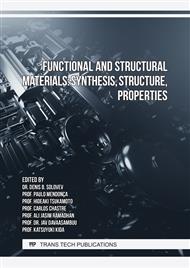[1]
O.A. Nasibullina, Studying the effect of tempering temperature during heat treatment on the corrosion resistance of 13MN6 steel samples, Solid State Phenomena, 316 SSP, 2021, p.203–207.
DOI: 10.4028/www.scientific.net/ssp.316.203
Google Scholar
[2]
S.A. Yamshchikova, E.I. Yamshchikov, O.A. Nasibullina, Study of the effect of the film-forming substance on the corrosion resistance of intumescent paints, IOP Conference Series: Earth and Environmental Science. 666(3) (2021) 032070.
DOI: 10.1088/1755-1315/666/3/032070
Google Scholar
[3]
A.L. Karpov, M.Z. Zaripov, A.M. Fayrushin, Аnalysis of methods of protection of inner surface of welds of field pipelines, IOP Conference Series: Earth and Environmental Science. 666(4) (2021) 042037.
DOI: 10.1088/1755-1315/666/4/042037
Google Scholar
[4]
I.R. Kuzeev, I.G. Ibragimov, M.I. Bayazitov, S.N. Davydov, I.R. Khairudinov, Steel corrosion prevention in coking residual petroleum stocks, Chem. and Technology of Fuels and Oils. 22 № 3 (1985) 111-113.
DOI: 10.1007/bf00726125
Google Scholar
[5]
E.S. Gaysin, Y.A. Frolov, O.A. Nasibullina, Estimate Tank Quality Margin, IOP Conference Series: Earth and Environmental Science. 459(3) (2020) 032055.
DOI: 10.1088/1755-1315/459/3/032055
Google Scholar
[6]
A.S. Tyusenkov, A.V. Rubtsov, R.R. Tlyasheva, Heat Resistance of Certain Structural Steels, Solid State Phenomena. 265 (2017) 868-872.
DOI: 10.4028/www.scientific.net/ssp.265.868
Google Scholar
[7]
A.T. Faritov, Y.G. Rozhdestvenskii, S.A. Yamshchikova,. E.R. Minnikhanova, A.S. Tyusenkov, Improvement of the linear polarization resistance method for testing steel corrosion inhibitors, Russian Metallurgy (Metally). 11 (2016) 1035–1041.
DOI: 10.1134/s0036029516110070
Google Scholar
[8]
O.A. Nasibullina and A.S. Tyusenkov, The study of cracks of X70 steel sample selected from the focal zone of destruction, IOP Conf. Ser.: Mater. Sci. Eng. 537 (2019) 022018.
DOI: 10.1088/1757-899x/537/2/022018
Google Scholar
[9]
M.V. Vakulenko, N.V. Zharinova, Logic-sense model of primary oil processing plant safety assurance, IOP Conference Series: Materials Science and Engineering. 862(3) (2020) 062022.
DOI: 10.1088/1757-899x/862/6/062022
Google Scholar
[10]
D.V. Karetnikov, R.G. Rizvanov, A.M. Fairushin, K.S. Kolokhov, Increasing the reliability of oil and gas equipment working in the conditions of steep temperature gradients, Welding International. 27 № 7 (2013) 557-560.
DOI: 10.1080/09507116.2012.715949
Google Scholar
[11]
O.A. Nasibullina, A.G. Gareev, R.G. Rizvanov, Investigation of the Hydrogen Stratification of the Metal of the Active Gas Pipeline. Solid State Phenomena. 284 (2018) 1302-1306.
DOI: 10.4028/www.scientific.net/ssp.284.1302
Google Scholar
[12]
M.Z. Zaripov, A.M. Fairushin, D.V. Karetnikov, Conditions of Possible Application of Vibration Processing in the Course of Welding, Materials Science Forum. 946 (2019) 883-888.
DOI: 10.4028/www.scientific.net/msf.946.883
Google Scholar
[13]
I.G. Abdullin, A.G. Gareev, Corrosion fatigue durability of pipe steel in carbonate-bicarbonate media. Fiziko-Khimicheskaya Mekhanika Materialov. 29, 5 (1993) 97-98.
DOI: 10.1007/bf00558780
Google Scholar
[14]
O.A. Nasibullina, R.G. Rizvanov, The study of the destruction of pipelines, subject to stress corrosion cracking. Materials Science Forum. 992 (2020) MSF, 695–699.
DOI: 10.4028/www.scientific.net/msf.992.695
Google Scholar
[15]
R.G. Rizvanov, D.Sh. Mulikov, D.V. Karetnikov, A.M. Fairushin, A.S. Тokarev, Evaluation ofthe Possibility of Obtaining Tube-to-Tube Sheet Welded Joints of 15Cr5Mo Steel by Alternative Technological Process, 4th International Conference on Advanced Engineering and Technology (4th ICAET), IOP Publishing IOP Conf. Series: Materials Science and Engineering 317 (2018) 01207.
DOI: 10.1088/1757-899x/317/1/012077
Google Scholar
[16]
O.A. Nasibullina, A.G. Gareev, Destruction patterns of X70 steel sample, possessing cracks of corrosion-mechanical origin, under cyclic loading, Materials Science Forum. 946 (2019) 20-24.
DOI: 10.4028/www.scientific.net/msf.946.20
Google Scholar
[17]
N.V. Zharinova, M.V. Vakulenko, Ensuring industrial safety of pipelines with developed hard sections, IOP Conference Series: Materials Science and Engineering. 862(3) (2020) 032014.
DOI: 10.1088/1757-899x/862/3/032014
Google Scholar


